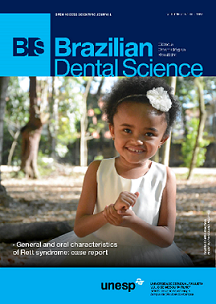Biomechanical behavior of indirect composite materials: a 3D-FEA study
DOI:
https://doi.org/10.14295/bds.2017.v20i3.1444Abstract
Objective: This study aimed to evaluate the influence of the elastic modulus of indirect composite resins (ICR) in the stress distribution of a restored maxillary first premolar. Material and methods: A three-dimensional (3D) finite element model of the tooth and the mesial-occlusal-distal (MOD) restoration was created. Three ICR were simulated, by changing the elastic modulus: 10, 15 and 20 GPa. All materials were considered as isotropic, homogeneous and linearly elastic. An occlusal load (200 N) was applied on occlusal surface trough a sphere, and the nodes of the external surface of the root were fixed. The maximum principal stresses on the tooth and restoration were analyzed. Results: According to FE analysis, the lower the ICR elastic modulus, the higher the stress values generated on the remaining tooth. For the restoration, the opposite was observed: the lower the modulus, the lower the stress. Conclusion: With the limitations of this study it is possible to conclude that the greater the elastic modulus of the restorative material the harder it will be to deflect the cusps, but the easier the fracture of the resin.
Keywords: Finite Elements Analysis; Composite Resin; Indirect Restoration; Flexural Strength.
Downloads
Downloads
Published
How to Cite
Issue
Section
License
Brazilian Dental Science uses the Creative Commons (CC-BY 4.0) license, thus preserving the integrity of articles in an open access environment. The journal allows the author to retain publishing rights without restrictions.
=================




























